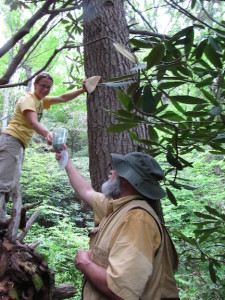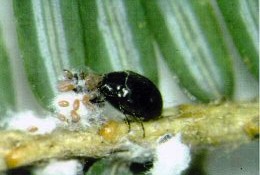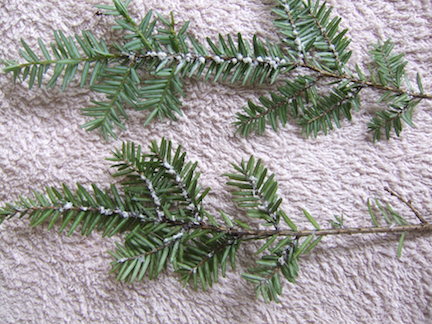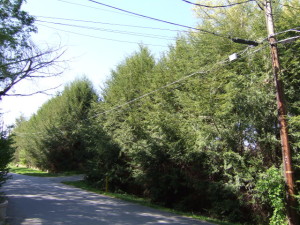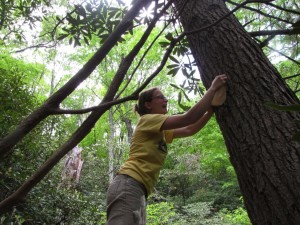Biological Control of Hemlock Woolly Adelgid
Larval and Adult Sasajiscymnus tsugae feeding on HWA ovisacs(Photos: courtesy of Carole Cheah, Ph.D., CAES) |
What is biological control of Hemlock Woolly Adelgid?
Biological control of the Hemlock Woolly Adelgid (HWA) uses predator organisms that can reduce HWA populations to a level that does not harm our native hemlocks. The Sasajiscymnus tsugae (St) predator beetle, which is the native predator for our imported HWA from Japan, is the most effective HWA biocontrol option for our hemlocks.
Over 3 million Sasajiscymnus tsugae beetles produced by taxpayer-supported, USDA labs have been released by USDA/USFS to initiate biological control of HWA in national and state parks and forests in the eastern US. But saving most municipal and private hemlock areas will depend on purchases of these same St predator beetles by private individuals and groups. Fortunately, there is a commercial predator rearing lab to support the biological control strategies needed to protect our hemlock ecosystems.
The hemlock woolly adelgid kills by overrunning and defoliating our native hemlocks. Heavy HWA infestation not only destroys existing foliage, it also suppresses the production of new hemlock foliage. So heavily HWA-infested hemlocks die from the loss of foliage needed for water take-up, respiration and food production. Sasajiscymnus tsugae predator beetles interrupt this destructive cycle by dramatically reducing adelgid populations, allowing hemlocks to resume producing new foliage and gradually recover.
Both adult St beetles and their developing larvae are voracious HWA predators. And because USDA research has established that these specialized predators cannot reproduce without an adelgid food source, Sasajiscymnus tsugae beetles have been approved (by USDA/APHIS) for public release in the eastern US.
How does Biocontrol of HWA work?
Biocontrol establishes an ecological balance between predator (Sasajiscymnus tsugae) and prey (Hemlock Woolly Adelgid) that allows hemlocks to survive and grow naturally. It does not eliminate HWA completely! Maintaining a long-term biological balance requires that HWA continue to exist, to support the feeding and reproduction of the predator beetles. A successful predator release will restore a natural balance in which predator beetles feed on Hemlock Woolly Adelgid populations, which are thereby limited to allow normal health and foliage growth in our native hemlocks.
It is important to note that not all HWA predators are equally effective in controlling HWA. Recent USDA research reports that winter-feeding HWA predators such as Laricobius species, which overlap only with the first of two HWA reproductive cycles, cannot provide effective population control for HWA (without the help of a second, summer-feeding predator, such as St). In contrast, summer-feeding Sasajiscymnus tsugae feeds on both HWA population cycles, providing effective, stand-alone HWA control.
Once the predator beetles are established, it is easy to monitor Sasajiscymnus tsugae (St) predator beetle activity and its effects on Hemlock Woolly Adelgid. Each of the two HWA reproductive cycles (October-April, May-July) begin with new white “cotton-ball” ovisacs at the base of hemlock needles. So if you turn over an infested branch and see all round balls, then the beetles have not yet begun feeding at that site. But in feeding, the beetles tear open the HWA ovisacs to consume HWA and eggs, leaving shreds of white residue. The photo below shows the “before” and “after” of St predator beetle predation. The upper twig – not yet visited by the predators – has many round HWA ovisacs, each containing a single HWA and its many eggs. The lower twig (from a nearby branch) has had all HWA ovisacs recently destroyed by St predator beetles, leaving only white residues where the HWA ovisacs were previously attached. Yum Yum!
Where did “our” Hemlock Woolly Adelgid come from?
The HWA that is devastating our eastern hemlocks was introduced from Southern Japan between 1910-1915 on Japanese-origin horticultural (conifer) nursery stock which were imported for garden projects at several Gilded Age Estates in the eastern US. (These HWA introduction sites did not include one of the largest eastern Gilded Age Garden projects at the Vanderbilt’s Biltmore Estate. For more on biological control of HWA at Biltmore Estate, go to Biltmore.)
Where did our HWA Predator come from?
Biocontrol efforts for Hemlock Woolly Adelgid in the eastern US were initiated by entomologists at the Connecticut Agricultural Experiment Station (CAES) in the early 1990’s. The objective was to locate and test (under quarantine) predator organisms that could control HWA population growth. Curiously, the first CAES quest for an HWA predator went to southern Japan – which 15 years later would be identified, by DNA analysis, as the origin of the HWA introduced to the eastern US!! How did that happen?
In the 1980’s, CAES entomologist Mark McClure published several articles documenting Japanese garden sites in which both Eastern (T. canadensis) and Southern Japanese (T. seiboldii) hemlocks were observed in good health with evidence of HWA infestation. So these healthy Eastern hemlocks with HWA present in Osaka, Japan, attracted CAES explorations in the early 1990’s – which discovered the HWA predator, now known as Sasajiscymnus tsugae. As a result, the native predator for our HWA “import” had already been evaluated and USDA/APHIS approved for release in the Eastern US, well before the southern Japanese origin of this HWA was confirmed. And there is a commercial source for this effective HWA predator.
Predation and Resistance in Hemlock Woolly Adelgid control
In its Southern Japanese homeland area, the presence of Hemlock Woolly Adelgid does not damage the native hemlock – Tsuga sieboldii, even though this hemlock species is very similar to our Eastern and Carolina hemlocks in having low levels of biological resistance to this HWA. (See 2008 Research Report on Resistance of Hemlock Species to HWA) So this confirms the critical importance biological control for hemlock survival in southern Japan. And the native predator beetle that controls this HWA in Japan is a small, black ladybird beetle by the name of Sasajiscymnus tsugae (until 2004 it was called Pseudoscymnus tsugae – same beetle, different name.)
Thanks to Nathan Havill’s ground-breaking DNA-mapping research on HWA, we now recognize that the Hemlock Woolly Adelgid found in the Pacific Northwest, which was once thought to be the source for our HWA infestation in the eastern US, is a different biological organism from our HWA import. And both western and eastern hemlock species show considerable natural resistance to this western HWA strain, which has been present for centuries in the Pacific Northwest. The western HWA is rarely found on wild hemlocks in the Pacific NW, and is not considered a plant pest by state authorities. This suggests a limited biocontrol role in eastern US for the western HWA predator beetle, Laricobius nigrinus, as well as other possible HWA predators from the Pacific Northwest!
How effective is Sasasajiscymnus tsugae as an HWA predator ?
In 1995 USDA approved St for field release, and careful CAES field research activities have established the effectiveness of St as an Hemlock Woolly Adelgid predator. (See the 2011 Research Report on Sasajiscymnus tsugae). These field research results include up to 80% adelgid reductions in a single season, a 2 generation-per-year (bivoltine) reproductive cycle that allows St to match the exponential growth capability of Hemlock Woolly Adelgid, an ability to match HWA in over-wintering in cold winter climates, and an ability to move (and expand coverage) considerable distances over the course of a single season.
A grass-roots community effort in the Brevard NC area has involved city and county governments, conservation groups, summer camps, neighborhood associations and individual landowners in an HWA biocontrol effort that should safeguard the future health of hemlocks in the “greater Brevard area”. Eight years after multiple St releases in Brevard and surrounding mountain woodland areas, we can see hemlock restoration underway – with increasing new foliage production and reduced adelgid populations in both urban and wild hemlock areas. See hemlock restoration in action in western North Carolina.
Recovering Hemlock Hedge in Brevard
So the success of the Brevard experience offers an urban “proof of concept” that once established, Sasajiscymnus tsugae can maintain HWA populations at levels that can be tolerated by our Eastern hemlocks. A release of St beetles in 2007, funded by Transylvania County and implemented by Ecology students at Brevard College has created a protective zone for hemlock recovery and growth in central Brevard, originating at the Silvermont Mansion release site and extending over the surrounding residential areas as well as the Brevard College campus. And the actions of numerous individual property owners and neighborhood groups have extended this protective covering over much of central Brevard, as well as outlying areas.
More recently, the Carolina Mountain Land Conservancy (CMLC) has encouraged and assisted its conservation easement property owners in initiating HWA biocontrol efforts in hemlock areas throughout CMLC’s multi-county area in western North Carolina. But it has placed special emphasis on protecting Carolina Hemlock colonies on Land Trust conservation lands in the Hickory Nut Gorge area. Below are CMLC Stewardship Director Julia Brockman and CMLC volunteer Patrick Horan releasing St beetles on a large (31″ DBH) Carolina Hemlock on CMLC’s Weed Patch property in the NC Hickory Nut Gorge. Often the hardest part of a release on a large tree like this is fastening the coffee filter to the trunk! But how polite would it be to wish your little predators “Bon appetit” and then dump them on the ground? (For more information on CMLC’s hemlock restoration efforts, involving both Carolina hemlocks (Tsuga caroliniana) and eastern hemlocks (Tsuga canadensis), go to Community page.)